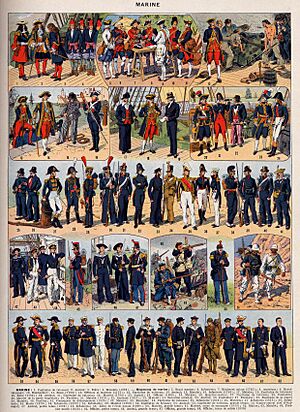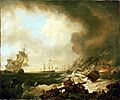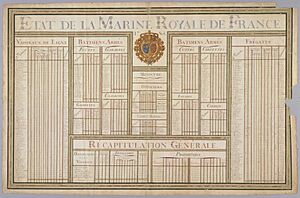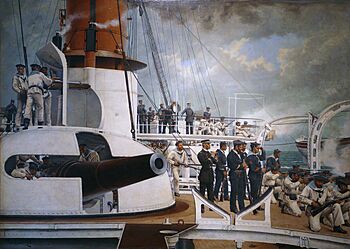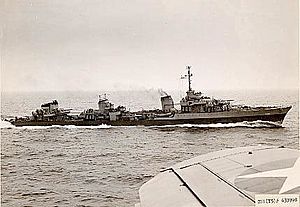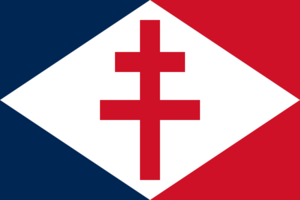History of the French Navy facts for kids
The history of the French Navy is a long and exciting one! While it started way back in the Middle Ages, its real journey began with Cardinal Richelieu under King Louis XIII.
France faced some big challenges with its navy. First, its coastline was split into two parts by Spain and Portugal. This meant France had to build and maintain two separate navies, one for the Mediterranean Sea and one for the Atlantic Ocean. Second, France's biggest threats usually came from land, from countries in Central Europe. This meant the country often focused more on building a strong army than a strong navy. Lastly, support for the navy was not always steady. Navies need a lot of money and effort to keep ports, shipyards, and trained crews ready. Sometimes, a lack of money or understanding caused problems, leading to amazing naval successes followed by tough times.
The story of the French Navy can be split into different periods:
- It started with the first real State Navy under Louis XIII, thanks to Richelieu. But this navy was almost destroyed by a period of unrest called the Fronde.
- It was rebuilt and had a brilliant time under King Louis XIV, largely thanks to Jean-Baptiste Colbert. However, this effort wasn't continued later, leading to big losses in the Seven Years' War and the French and Indian War.
- Then came a period of rebirth under Choiseul, which reached its peak under King Louis XVI. During this time, Admiral de Grasse won a key victory at the Battle of the Chesapeake during the American Revolutionary War. Explorers like Bougainville also sailed the world, mapping new places. But then, the French Revolution and the First Empire caused the navy to struggle, giving Britain control of the seas.
- Under Napoleon III, a modern navy was built using new technologies like steam power and ship armor. This new fleet helped France build and keep its empire. The navy stayed strong, and before the two world wars (1925–1939), a big effort was made to prepare for threats from Germany and Italy. When France fell in 1940, most of the Navy didn't get a chance to fight. What survived the attack at Mers-el-Kebir was later destroyed in the scuttling of the French fleet at Toulon.
Contents
- What's in a Name?
- Early Days: The Middle Ages
- Louis XIII and Richelieu: Building a Strong Navy
- Louis XIV and Colbert: The Sun King's Navy
- Louis XV: A Time of Decline and Rebuilding
- Louis XVI: Exploration and American Independence
- French Revolution and Napoleon's Empire
- From Restoration to the Second Empire
- World Wars
- The Modern French Navy
- See also
What's in a Name?
The French Navy is often called La Royale (meaning "the Royal"). No one is completely sure why. Some people think it's because of its strong connection to the French monarchy. Others believe it's because the navy was officially called "royale" before it was named "nationale." Or, it might simply be because its main office was on Rue Royale in Paris.
Early Days: The Middle Ages
In the Middle Ages, most fleets, including France's, were made up of merchant ships that were used for war when needed. The French Navy's early history includes a victory over the English Navy at the Battle of Arnemuiden on September 23, 1338. This battle was also the first naval battle where cannons were used. However, the French Navy suffered a huge defeat at Sluys, losing almost 200 ships and up to 20,000 men. The English, by contrast, lost only 2 ships and 600 men.
The tears of our sovereigns have the salted taste of the sea that they ignored.

When King Henry IV ruled, France was not very stable. It was trying to be independent from Spain and the Pope. This meant France focused a lot on its army, which used up many resources. Also, France was allied with England, which would not have liked France to challenge its strong navy.
When Richelieu became the Minister of the Navy, he decided to build a powerful new navy. He planned for two separate forces.
The Mediterranean force was to have galleys, which were good for the calm seas there. He initially wanted 40 galleys but ended up with 24, partly because there weren't enough galley slaves. Each galley needed 400 or 500 slaves to row it.
The oceanic force was made up of men-of-war. These were medium-sized ships, as France didn't have many harbors for very large ones. But they were heavily armed with big cannons. These ships weighed between 300 and 2000 tons and carried up to 50 large 24-pound cannons. The first ships were bought from the Dutch. Then, France started building its own, like the famous Couronne, a very impressive ship for its time.
In 1627, the Navy wasn't ready to fight the English fleet at the Siege of La Rochelle. This led to building a seawall to create a blockade. Back then, fleets often had many merchant ships quickly fitted with cannons. These ships were often short on crew and not well-managed.
With new warships and trained sailors, the French Navy gained experience in the Franco-Spanish War and the Thirty Years' War. They won important battles like the Battle of Cádiz (1640), led by France's first Grand Admiral, Jean Armand de Maillé-Brézé. The Navy also helped build a French empire, taking control of areas like "Nouvelle-Guyenne" (now Acadia), "Nouvelle France" (now Canada), Tortuga, Martinique, Guadeloupe, other Caribbean islands, the Bahamas, and Madagascar.

Under King Louis XIV, known as the "Sun King," the French Navy received a lot of money and equipment. It won several early victories in the Nine Years' War against the Royal Navy and the Dutch Navy. However, money problems later forced the navy to stay in port, allowing the English and Dutch to take control of the seas.
Thanks to Jean-Baptiste Colbert's big plans for shipbuilding, the French Navy became very grand, matching the style of Louis XIV's era. It also became a truly important military force. The ship of the line Soleil Royal is a great example of the impressive ships built then. Colbert is also known for creating many of France's naval traditions.
The French Navy of this time was also a leader in developing naval tactics. Paul Hoste (1652–1700) wrote the first major book on how to fight naval battles.
Before the Nine Years' War, in the Franco-Dutch War, the French Navy won a big victory over a combined Spanish-Dutch fleet at the Battle of Palermo (1676).
During the War of the Grand Alliance, Admiral Tourville won a significant victory at the Battle of Beachy Head (1690). France gained control of the English Channel. This event is seen as one of the French Navy's most glorious moments, and Tourville is still famous today. Many ships were named Bévezier or Tourville to remember the battle.
The Battles of Barfleur and La Hougue in 1692 saw a French fleet fight an Anglo-Dutch fleet. Both sides suffered heavy losses. However, when the wind and tide changed, the French ships struggled to return to port for repairs. Some damaged French ships had to be beached at Cherbourg, where English boats and fire ships destroyed them. The crews were saved, but 15 ships of the line were lost and not replaced. For decades after this, France did not seriously challenge the combined English and Dutch fleet.
Instead, France focused on attacking enemy merchant ships, which was very successful under captains like Jean Bart, Claude de Forbin and René Duguay-Trouin.
Louis XV: A Time of Decline and Rebuilding
Until 1759, the French and British navies had a fairly equal record in their many fights. But this changed dramatically in 1759, a year of disasters for France. France had started the year planning to invade Britain. The British responded by blocking the French fleets at Toulon and Brest. When the French ships finally came out, they were soundly defeated in the battles of Lagos, Portugal and Quiberon Bay. The French Navy also couldn't stop the loss of important colonies like New France (Quebec) and Guadeloupe. This year marked the beginning of clear British control of the seas.
After the terrible losses of the Seven Years' War, France didn't have enough money to build a fleet strong enough to challenge Britain's Royal Navy. However, efforts were made. By the time King Louis XV died in 1774, the Marine Royale was a bit larger than it had been in 1763. More importantly, many old ships had been replaced with better, modern designs. Also, in 1766, Bougainville led the first French trip around the world.
Louis XVI: Exploration and American Independence
King Louis XVI was very interested in science and geography. He encouraged explorations, even sending Jean-François de Galaup, comte de Lapérouse on long voyages of discovery. (Lapérouse's expedition, 1785–1788, was France's answer to Captain Cook's voyages). On August 1, 1785, Lapérouse left Brest, France, commanding L'Astrolabe and La Boussole on a scientific trip to the Pacific. He never returned, and his ships were later found wrecked at Vanikoro island in the South Pacific.
Ships designed by French engineer Jacques-Noël Sané began to be built during the American Revolutionary War. He created what became the best designs for wind-powered fighting ships. His standard frigates carried 18-pounder guns, and his ships of the line had 64, 74, 80, or 118 guns. His 74-gun ship of the line became a key ship for both the French and British navies. The largest ships, with 118 guns, were said to be "as easy to steer as a frigate." The Océan class is a good example.
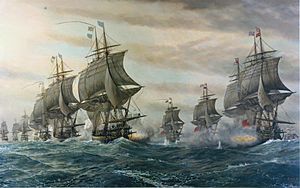
During the American War of Independence, the French Navy played a crucial role in helping the American side. The French Navy was the only major navy to fight the British, alongside the smaller American navies. In a tough fight, the French under Admiral de Grasse managed to push back a British fleet at the Battle of the Chesapeake in 1781. This victory ensured that the French and American ground forces would win the Battle of Yorktown. De Grasse's career ended when he was captured during the French defeat at the 1782 Battle of the Saintes.
In India, Suffren fought a series of campaigns against the British (1770–1780), trying to gain control of the seas against Vice-Admiral Sir Edward Hughes.
By 1789, the French Navy had 71 ships of the line, 64 frigates, 45 corvettes, and 32 smaller ships. Another 12 ships of the line and 10 frigates were being built. The crews included 75,000 sailors, 5,000 gunners, 2,000 officers, and 14,000 Fusiliers Marins (naval infantry). Ships were mostly based in Brest, Toulon, and Rochefort, as well as in Lorient, Le Havre, Dunkerque, Bordeaux, Bayonne, and Marseille.
French Revolution and Napoleon's Empire
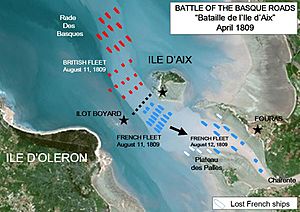
The French Revolution caused great damage to the French Navy. Many officers from noble families were removed or left, which almost crippled the navy.
The National Convention even got rid of the Fleet Gunners Corps. This stopped gunnery training, making the cannons much less accurate and slower to fire. The French strategy was to shoot at the enemy ships' rigging to disable them. This worked with highly trained crews but was difficult with poorly trained gunners. This led to times when French ships couldn't hit British ships even when they were exposed (like in the fight of the Ça Ira, or at the start of the Battle of Trafalgar). In contrast, the Royal Navy trained its gunners to shoot at the enemy's hull, which was an easier target. This killed and injured the crew and slowly reduced the enemy's firepower.
Efforts to make the navy strong again under Napoleon failed. This was partly due to the death of Latouche Tréville in 1804, and the Battle of Trafalgar in 1805. In this battle, the British almost completely destroyed a combined French and Spanish fleet. This disaster ensured British control of the seas during the Napoleonic Wars.
After Trafalgar, the French Navy mostly focused on frigate actions and privateers like Robert Surcouf. This started a French trend of preferring many smaller, powerful, and fast ships over large capital ships.
From Restoration to the Second Empire
In the 1800s, the French Navy recovered and became the second-best navy in the world, after the Royal Navy.
During this time, explorer and naval officer Dumont d'Urville explored the Southern and Western Pacific, Australia, New Zealand, and Antarctica. He brought back new plants and animals.
The French Navy also successfully blocked Mexico in the Pastry War of 1838. It also destroyed the Imperial Chinese Navy at the Battle of Fuzhou in 1884. The navy also helped connect the growing parts of the French empire. The French Navy was a leader in developing warships. They made improvements to existing designs and also pioneered new technologies. These included steam power, the screw propeller, armor plating, steel construction, and protected gun mounts.
- France led the way in developing cannons that fired shells for the Navy, invented by Henri-Joseph Paixhans.
- In 1850, Napoléon became the first battleship built specifically to be powered by steam.
- Gloire became the first seagoing ironclad (an armored warship) when it was launched in 1853.
- In 1863, the French Navy launched Plongeur, the first submarine powered by an engine.
- In 1876, the Redoutable became the first warship with a steel hull.
-
Napoléon (1850).
Global Actions
In a famous speech in 1852, Napoleon III said, "The Empire means peace." However, he was determined to have a strong foreign policy to increase France's power and glory. The French Navy was involved in many actions around the world.
Crimean War
Napoleon III challenged Russia's claims in the Ottoman Empire. This led to France's successful involvement in the Crimean War (March 1854–March 1856). During this war, Napoleon successfully formed an alliance with Britain, which continued after the war ended.
The French ship of the line Henri IV and the corvette Pluton ran aground after a storm that destroyed many Allied ships. The remains of Henri IV were used to build a fortress. The Pluton was completely lost.
East Asia

Napoleon III began to establish French colonial influence in Indochina. He approved a naval expedition in 1858 to punish the Vietnamese for their bad treatment of French Catholic missionaries. He also wanted to force Vietnam to accept a French presence. A key reason for his decision was the belief that France risked becoming a less important power if it didn't expand its influence in East Asia. Also, the idea that France had a "civilizing mission" was becoming popular. This eventually led to a full invasion in 1861. By 1862, the war was over. Vietnam gave France three southern provinces, which the French called Cochinchina. Vietnam also opened three ports to French trade, allowed French warships free passage to Cambodia (which led to a French protectorate over Cambodia in 1867), allowed French missionaries to work freely, and paid France a large amount for the cost of the war.
In China, France took part in the Second Opium War. In 1860, French troops entered Beijing. China was forced to give more trading rights, allow free travel on the Yangtze river, give full rights and religious freedom to Christians, and pay France a huge amount of money. This, along with the action in Vietnam, set the stage for more French influence in China, leading to France having a sphere of influence over parts of Southern China.
In 1866, French Navy troops tried to colonize Korea. The French Navy also had a small presence in Japan in 1867–1868, related to a French military mission to Japan and the later Boshin War.
Mexico
The French Navy was heavily involved in the French intervention in Mexico (January 1862–March 1867). Napoleon III used Mexico's refusal to pay its foreign debts as an excuse. He planned to create a French-supported monarchy in Mexico, hoping to establish French influence in North America. Mexican conservatives, tired of the anti-church Mexican republic, supported this plan.
Battleships Before Dreadnoughts
In the 1880s, a naval idea called the Jeune École (Young School) was very popular in the French Navy. This idea, based on privateer warfare, focused on small, fast ships like torpedo boats and cruisers with shell-firing guns. It wrongly thought that battleships were outdated. However, in the early 1890s, the pre-dreadnought battleship came back strong with new defenses against torpedoes and mines. Torpedo boats, it turned out, were not good enough for the open ocean.
French capital ships of this time were easy to spot. They were small (10,000 tons), had huge ram bows, were very tall, and had a noticeable inward slope of the hull (tumble-home). They often carried only half the main guns of British ships of the same time. French battleships had armored masts with electric elevators inside, very large funnels, and complex systems to swing boats out from the narrow upper decks.
France built many of these ships, though they weren't as uniform in design as those in Britain and Germany. The Bouvet, Masséna, and Jauréguiberry were built as "sample battleships" while the design for a true class of battleships was being worked on. This eventually led to the 3-ship Charlemagne class class, which had guns almost as powerful as their British rivals.
France's advanced ideas and technology attracted Japan. The French engineer Émile Bertin was invited to Japan for four years to design a new fleet for the Imperial Japanese Navy. This new fleet helped Japan succeed in the First Sino-Japanese War in 1894. French shipyards were busy building warships for other countries, especially Imperial Russia, which copied French styles for many of its cruisers and battleships. Even though France was ahead in some technologies (like boilers and metalwork), it couldn't build as many ships as its rivals, Britain and Germany.
Around 1900, French ship designs started to be influenced by other countries. Their newer battleships had two twin 300mm gun turrets instead of single ones. They also had less exaggerated tumble-home and no ram bows. This made the ships better at sea, though they remained small.
With the Liberté class class (finished in 1907), French pre-dreadnought design finally matched U.S. and British standards. But 1907 also saw the launch of HMS Dreadnought, which made all other capital ships in the world outdated overnight. Until 1911, while rival navies were building new dreadnoughts, all of France's shipyards were busy building the six-ship Danton class pre-dreadnoughts. These ships had modern turbine engines but still only carried four heavy guns each, while a dreadnought had at least ten.
The first French dreadnoughts didn't appear until 1914. Two classes with a total of seven ships, the Courbet and Bretagne classes, were finished during World War I. With the alliance with Britain, France's naval forces were mostly in the Mediterranean Sea. Their main job was to face the Austro-Hungarian fleet in the Adriatic Sea. Meanwhile, a large fleet of cruisers was also built. These served in the Mediterranean, the English Channel, and in France's colonies in Indochina, the Pacific Islands, West Africa, and the Caribbean.
World Wars
The French Navy's development slowed down in the early 1900s. Because of this, it had fewer ships than the German and US Navies. It was also late in building new dreadnought battleships and light cruisers. When World War I began, it had relatively few modern ships: only one dreadnought was ready, with all four Courbets ready by the end of 1914, and three improved dreadnoughts by mid-1916. During the war, France focused most of its effort on land. While battleships already being built were finished, few new warships were started. Despite its older ships, the French Navy performed well in World War I. Its main operation was the Dardanelles Campaign. France's biggest losses during the war were four pre-dreadnought battleships, which were sunk by mines and U-boat torpedoes.
Here are some of the major ships in the French Navy at the start and end of World War I:
- dreadnought battleships: 4 at start / 7 at end
- pre-dreadnought battleships: 17 at start / 13 at end
- armoured cruisers: 22 at start / 18 at end
- protected cruisers: 13 at start / 12 at end
- destroyers: 35 at start / 42 at end (ships over 500 tons)
- torpedo boats: 180 at start / 164 at end
- submarines: 50 at start / 61 at end
The First Seaplane Carrier
The invention of the seaplane in 1910 with the French Fabre Hydravion led to the first ships designed to carry aircraft. In 1911, the French Navy's Foudre became the first seaplane carrier. It was used to carry float-planes in hangars on its main deck. A crane would lower them onto the sea. Foudre was later changed in November 1913 to have a 10-meter flat deck to launch its seaplanes.
The Idea of the Flat-Deck Carrier
| "An airplane-carrying vessel is indispensable. These vessels will be constructed on a plan very different from what is currently used. First of all the deck will be cleared of all obstacles. It will be flat, as wide as possible without jeopardizing the nautical lines of the hull, and it will look like a landing field." |
| Clément Ader, L'Aviation Militaire, 1909 |
As airplanes developed in the early 1900s, navies became interested in using them to scout for their big warships. In 1909, the French inventor Clément Ader wrote a book called L'Aviation Militaire. In it, he described a ship to operate airplanes at sea. It would have a flat flight deck, a control tower (island superstructure), deck elevators, and a hangar bay. That same year, the US Naval Attaché in Paris sent a report about Ader's ideas. The first tests to try out this concept were done in the United States starting in 1910.
Building the Fleet Between the World Wars
Every navy has many different types of ships. No navy has enough money to make every ship the best in its class. However, different countries try to be excellent in certain types of ships. Between the world wars, the French fleet was known for building a few ships that were "over the top" compared to similar ships from other countries.
For example, the French chose to build "super-destroyers." During World War II, the Allies considered these ships to be like light cruisers. This was a way to get around the Washington Naval Treaty, which limited cruisers and battleships but not destroyers. The Le Fantasque class class is still the fastest destroyer class ever built. The Surcouf submarine was the largest and most powerful of its time.
In 1933, the French Navy thought about building a super-battleship, the Lyon class. But these plans were canceled when the Germans built their "pocket battleships." The French responded with two ships of the Dunkerque type. These were fast battleships, somewhere between battlecruisers and battleships. The need for a large battleship was met with the Richelieu class class.
Second World War
At the start of World War II, the French Navy took part in operations against the Axis powers. It patrolled the Atlantic and attacked Genoa. However, France's surrender and the armistice terms completely changed everything. The French fleet immediately stopped fighting.
Destruction of the French Fleet and Vichy France
The British saw the French fleet as a dangerous threat. They worried that France might become an enemy, or more likely, that Nazi Germany's Kriegsmarine (navy) might take control of the French ships. It was vital that these ships be put out of action. Some French ships were in British-controlled ports in Britain or Egypt. These ships were either convinced to join the Free French forces or were boarded and disarmed.
However, important parts of the fleet were in Dakar and Mers-el-Kebir. The Royal Navy gave an ultimatum. When no agreement could be reached, they opened fire and sank or damaged much of the French fleet (Operation Catapult) on July 3, 1940. This was done to stop the fleet from falling into Axis hands. This action damaged relations between Britain and France and made it harder for other French ships to join the Allies. From this point on, the ships remaining in Vichy French hands tried to stay neutral towards the Axis powers while avoiding capture by the Allies and the Free French. They had some small tactical successes, like the battles of Dakar and Ko Chang, but these didn't change the overall disaster.
In November 1942, the Allies invaded French North Africa. In response, the Germans occupied (Case Anton) Vichy France, including the French naval port of Toulon. The main part of the surviving French fleet was there. Capturing these ships was a major German goal, and SS forces were sent to do it (Operation Lila). French naval leaders were divided on what to do. Admiral Jean de Laborde, commander of the High Seas Fleet, wanted to sail out and attack the Allied invasion fleet. Others, like the Vichy Secretary of the Navy, Contre-Amiral Gabriel Auphan, favored joining the Allies. On several warships, there were spontaneous protests in favor of sailing with the Allies, with crews chanting "Vive de Gaulle! Appareillage!" (Long live de Gaulle! Get ready to sail!).
However, orders to French commanders to sink their ships if an attempt was made to take them over had been strengthened. So, often despite German troops being present, this was done in the scuttling of the French fleet at Toulon. No capital ships and few other ships were captured in a condition that could be repaired. A few ships did manage to escape Toulon and join the Allies, most notably the submarine Casabianca.
After the Armistice and Appeal of 18 June, Charles de Gaulle created the Free French Forces, which included a naval branch called the Free Naval French Forces (Forces navales françaises libres, FNFL). To tell the FNFL apart from the Vichy French forces, Vice-Admiral Émile Muselier designed a special flag for the front of the ships. It had the French colors with a red cross of Lorraine. Aircraft also had a round symbol with the cross of Lorraine.
The French fleet was spread out. Some ships were in French ports. Others had escaped from France to British-controlled ports, mainly in Britain itself or Alexandria in Egypt. In the first part of Operation Catapult, the ships in the British ports of Plymouth and Portsmouth were simply boarded on the night of July 3, 1940. The then-largest submarine in the world, the Surcouf, which had sought safety in Portsmouth in June 1940 after the German invasion of France, tried to resist the boarding. In capturing the submarine, two British officers and one French sailor were killed. Other ships taken included the two older battleships Paris and Courbet, the destroyers Le Triomphant and the Léopard, 8 torpedo boats, 5 submarines, and other smaller ships.
Most of these ships were given to the FNFL (especially the submarine Surcouf). Others were leased by the British (like the corvette Aconit). These ships formed the beginning of a new naval force.
When French Africa joined the Allies, important ships based in Dakar were obtained. These included the cruisers Suffren, Gloire, Montcalm, Georges Leygues, and the battleship Richelieu.
Besides warships, the FNFL developed special forces. Captain Philippe Kieffer was inspired by British commandos to train new units called "Commandos Fusiliers-Marins." These later became the Commandos Marine. These commandos were very brave during the Battle of Normandy, climbing cliffs under fire to destroy German shore batteries. Captain Henri Honoré d'Estienne d'Orves tried to unite the French Resistance. He became an inspiring symbol when he was arrested by the Gestapo and executed.
The FNFL also had technical innovators. Captain Jacques Cousteau invented the modern aqua-lung. Yves Rocard improved radar. The aqua-lung became a major improvement for commando operations.
French warships of the FNFL supported the landings in southern France (Operation Dragoon) and Normandy (Operation Neptune). These units also played their part in the war in the Pacific. The Richelieu was present in Tokyo Bay when the Japanese Instrument of Surrender was signed.
French naval plans call for two aircraft carriers, but currently, France only has one, the Charles de Gaulle.
The navy is undergoing big changes in technology and equipment. A naval version of the Rafale jet is replacing older aircraft. Newer strategic submarines of the SNLE-NG type have mostly replaced the older SNLE submarines. A new nuclear ballistic missile is being tested and was expected by 2008. The experience gained from building the SNLE-NG will also lead to a newer type of nuclear attack submarines, expected by 2017. Surface forces are increasing in number and becoming more modern, with two large destroyers and 11 frigates planned. More modern missiles are being added, including cruise missile capabilities.
See also
- Military history of France
Important People
- Raoul Castex, a major naval thinker in the 20th century
Politicians
- Jean de Vienne
- Forbin, a famous privateer
- Duquesne
- Tourville
- Jean Bart, a famous privateer
- Duguay-Trouin, a famous privateer
- Admiral de Grasse, who commanded the French fleet that helped the USA gain independence
Heroes of the First French Republic
- Casabianca
- Dupetit-Thouars
- du Chayla
- Surcouf
- Latouche-Tréville
- Admiral Villaret-Joyeuse
Explorers
- Jacques Cartier
- Champlain
- Bougainville
- Lapérouse
- d'Entrecasteaux
- Nicolas Thomas Baudin
- Dumont d'Urville
- Savorgnan de Brazza
- Captain Cousteau
- Admiral Courbet
- Pierre-Charles Villeneuve, commander of the French and Spanish fleets at the Battle of Trafalgar
- Pierre Loti, known for his writings
Lists of Ships
- List of ships of the line of France
- List of French sail frigates
- List of battleships of France
- Current French Navy ships
- List of French Navy ship names
- Three ships were named for the Grand Admiral of France: see French ship Maillé Brézé
- List of French naval battles


